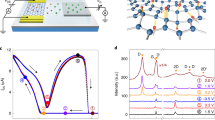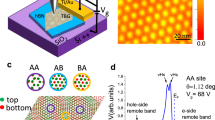Abstract
The electronic bandgap is an intrinsic property of semiconductors and insulators that largely determines their transport and optical properties. As such, it has a central role in modern device physics and technology and governs the operation of semiconductor devices such as p–n junctions, transistors, photodiodes and lasers1. A tunable bandgap would be highly desirable because it would allow great flexibility in design and optimization of such devices, in particular if it could be tuned by applying a variable external electric field. However, in conventional materials, the bandgap is fixed by their crystalline structure, preventing such bandgap control. Here we demonstrate the realization of a widely tunable electronic bandgap in electrically gated bilayer graphene. Using a dual-gate bilayer graphene field-effect transistor (FET)2 and infrared microspectroscopy3,4,5, we demonstrate a gate-controlled, continuously tunable bandgap of up to 250 meV. Our technique avoids uncontrolled chemical doping6,7,8 and provides direct evidence of a widely tunable bandgap—spanning a spectral range from zero to mid-infrared—that has eluded previous attempts2,9. Combined with the remarkable electrical transport properties of such systems, this electrostatic bandgap control suggests novel nanoelectronic and nanophotonic device applications based on graphene.
This is a preview of subscription content, access via your institution
Access options
Subscribe to this journal
Receive 51 print issues and online access
$199.00 per year
only $3.90 per issue
Buy this article
- Purchase on Springer Link
- Instant access to full article PDF
Prices may be subject to local taxes which are calculated during checkout




Similar content being viewed by others
References
Sze, S. M. & Ng, K. K. Physics of Semiconductor Devices (Wiley-Interscience, 2006)
Oostinga, J. B., Heersche, H. B., Liu, X. L., Morpurgo, A. F. & Vandersypen, L. M. K. Gate-induced insulating state in bilayer graphene devices. Nature Mater. 7, 151–157 (2008)
Li, Z. Q. et al. Dirac charge dynamics in graphene by infrared spectroscopy. Nature Phys. 4, 532–535 (2008)
Wang, F. et al. Gate-variable optical transitions in graphene. Science 320, 206–209 (2008)
Li, Z. Q. et al. Band structure asymmetry of bilayer graphene revealed by infrared spectroscopy. Phys. Rev. Lett. 102, 037403 (2009)
Ohta, T., Bostwick, A., Seyller, T., Horn, K. & Rotenberg, E. Controlling the electronic structure of bilayer graphene. Science 313, 951–954 (2006)
Castro, E. V. et al. Biased bilayer graphene: semiconductor with a gap tunable by the electric field effect. Phys. Rev. Lett. 99, 216802 (2007)
Zhou, S. Y. et al. Substrate-induced bandgap opening in epitaxial graphene. Nature Mater. 6, 770–775 (2007)
Kuzmenko, A. B. et al. Infrared spectroscopy of electronic bands in bilayer graphene. Preprint at <http://arxiv.org/abs/0810.2400> (2008)
Geim, A. K. & Novoselov, K. S. The rise of graphene. Nature Mater. 6, 183–191 (2007)
Katsnelson, M. I., Novoselov, K. S. & Geim, A. K. Chiral tunnelling and the Klein paradox in graphene. Nature Phys. 2, 620–625 (2006)
Huard, B. et al. Transport measurements across a tunable potential barrier in graphene. Phys. Rev. Lett. 98, 236803 (2007)
Novoselov, K. S. et al. Two-dimensional gas of massless Dirac fermions in graphene. Nature 438, 197–200 (2005)
Zhang, Y. B., Tan, Y. W., Stormer, H. L. & Kim, P. Experimental observation of the quantum Hall effect and Berry's phase in graphene. Nature 438, 201–204 (2005)
Novoselov, K. S. et al. Unconventional quantum Hall effect and Berry’s phase of 2 pi in bilayer graphene. Nature Phys. 2, 177–180 (2006)
McCann, E. & Fal'ko, V. I. Landau-level degeneracy and quantum hall effect in a graphite bilayer. Phys. Rev. Lett. 96, 086805 (2006)
McCann, E. Asymmetry gap in the electronic band structure of bilayer graphene. Phys. Rev. B 74, 161403 (2006)
Min, H. K., Sahu, B., Banerjee, S. K. & MacDonald, A. H. Ab initio theory of gate induced gaps in graphene bilayers. Phys. Rev. B 75, 155115 (2007)
Lu, C. L., Chang, C. P., Huang, Y. C., Chen, R. B. & Lin, M. L. Influence of an electric field on the optical properties of few-layer graphene with AB stacking. Phys. Rev. B 73, 144427 (2006)
Guinea, F., Neto, A. H. C. & Peres, N. M. R. Electronic states and Landau levels in graphene stacks. Phys. Rev. B 73, 245426 (2006)
Abergel, D. S. L. & Fal'ko, V. I. Optical and magneto-optical far-infrared properties of bilayer graphene. Phys. Rev. B 75, 155430 (2007)
Ferrari, A. C. et al. Raman spectrum of graphene and graphene layers. Phys. Rev. Lett. 97, 187401 (2006)
Zhang, L. M. et al. Determination of the electronic structure of bilayer graphene from infrared spectroscopy. Phys. Rev. B 78, 235408 (2008)
Adam, S. & Sarma, S. D. Boltzmann transport and residual conductivity in bilayer graphene. Phys. Rev. B 77, 115436 (2007)
Hybertsen, M. S. & Louie, S. G. Electron correlation in semiconductors and insulators—band-gaps and quasi-particle energies. Phys. Rev. B 34, 5390–5413 (1986)
Novoselov, K. S. et al. Two-dimensional atomic crystals. Proc. Natl Acad. Sci. USA 102, 10451–10453 (2005)
Acknowledgements
This work was supported by the Office of Basic Energy Sciences, US Department of Energy under contract DE-AC03-76SF0098 (Materials Science Division) and contract DE-AC02-05CH11231 (Advanced Light Source). F.W., Y.Z. and T.-T.T. acknowledge support from a Sloan fellowship, a Miller fellowship and a fellowship from the National Science Council of Taiwan, respectively.
Author information
Authors and Affiliations
Corresponding author
Additional information
The authors declare no competing financial interests.
Supplementary information
Supplementary Figure
This file contains Supplementary Figure 1S with Legend. (PDF 374 kb)
Rights and permissions
About this article
Cite this article
Zhang, Y., Tang, TT., Girit, C. et al. Direct observation of a widely tunable bandgap in bilayer graphene. Nature 459, 820–823 (2009). https://doi.org/10.1038/nature08105
Received:
Accepted:
Issue Date:
DOI: https://doi.org/10.1038/nature08105
This article is cited by
-
Spontaneous broken-symmetry insulator and metals in tetralayer rhombohedral graphene
Nature Nanotechnology (2024)
-
Engineering correlated insulators in bilayer graphene with a remote Coulomb superlattice
Nature Materials (2024)
-
Towards growth of pure AB-stacked bilayer graphene single crystals
Nano Research (2024)
-
Graphene quantum dots as game-changers in solar cell technology: a review of synthetic processes and performance enhancement
Carbon Letters (2024)
-
A new 2D Janus family with multiple properties: auxetic behavior, straintunable photocatalyst, high Curie temperature ferromagnets, and piezoelectric quantum anomalous Hall insulator
Science China Materials (2024)
Comments
By submitting a comment you agree to abide by our Terms and Community Guidelines. If you find something abusive or that does not comply with our terms or guidelines please flag it as inappropriate.



